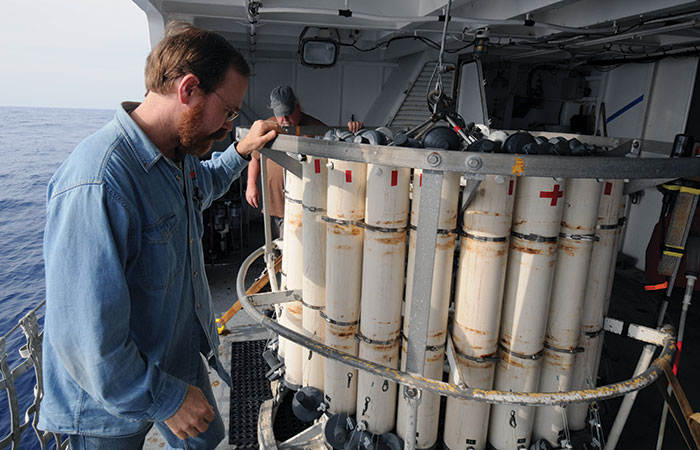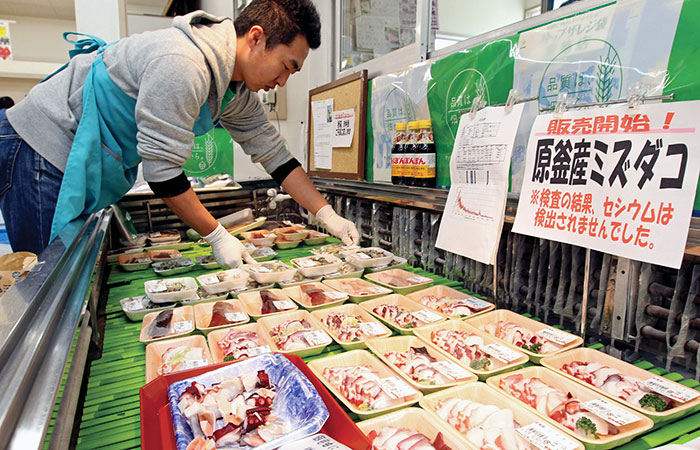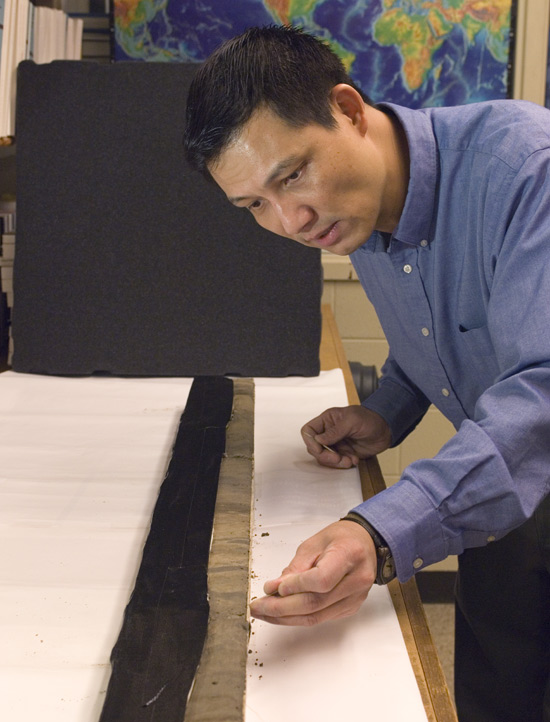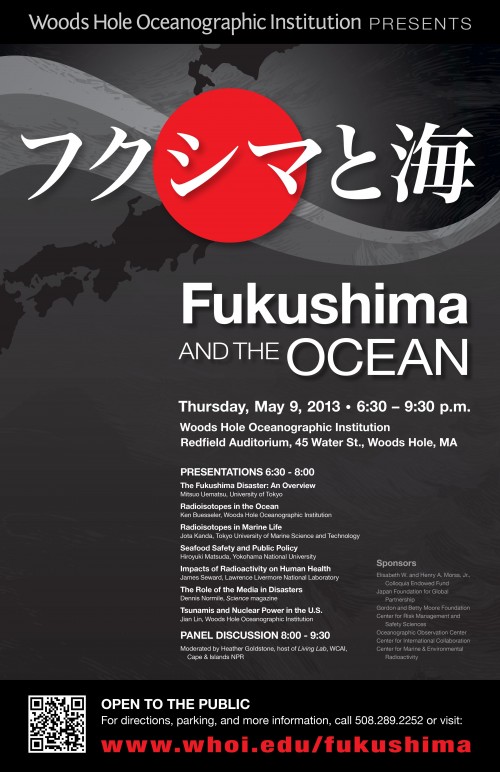Featured Stories, WHOI | May 14, 2013
The Fukushima Disaster: An Update
By Genevieve Wanucha
At 2:36 in the afternoon on March 11, 2011, a massive magnitude 9.0 seafloor earthquake rumbled off the northeast coast of Japan. The Fukushima Disaster began: the moving ocean floor displaced gigatons of seawater, unleashing coast-bound tsunami waves. 15,881 people died in the tsunami, 2,668 are still missing, and thousands of people were forced to suddenly and permanently re-locate. To add to these incalculable losses, the tsunami’s damage to the Dai-ichi nuclear plant led to the largest accidental release of radiation in the the ocean (note that US weapons testing in 1950’s and 1960s intentionally released the largest amount of cesium-137 world-wide, dwarfing Fukushima). Yet, no one, not even the clean-up workers, suffered serious radiation sickness or burns, though efforts to monitor for thyroid cancer in people exposed to low doses will continue for decades.
Now over 2 years later, answers to big questions about Fukushima’s ocean impact are emerging from ongoing research led by Japanese institutions and Woods Hole Oceanographic Institution. Last week’s WHOI colloquium, Fukushima and the Ocean, brought together seven experts to discuss the latest from seafood safety to future nuclear disaster prevention. Oceans at MIT brings you some new insights from the panelists:
Where did all the radiation that entered the ocean go? Where will it eventually wind up?
Within a couple week after the disaster, WHOI marine radiochemist Ken Buesseler had organized an international effort to launch a research cruise in the area. Enabled by a $3.7 million dollar grant from the George and Betty Moore Foundation, the scientists started the massive challenge of understanding the transport of radioisotopes off Japan’s coast. They focused on cesium-137 because of its ability to stick around, having a half-life of 30.17 years.

They ultimately found that, by May, cesium-137 isotope concentrations along the coast had dropped sharply. Buesseler explained that the the strong Kuroshio Current swept the radioactivity far out into the North Pacific where it diluted quickly in mixing waters. By June, Buesseler was measuring levels below the 7,000 bequarels of cesium-173 we are allowed in our drinking water (one becquarel equals one radioactive decay event per second). The takeaway is that as the radioactivity flows across the Pacific, it is getting so diluted that it doesn’t pose a direct health risk to humans in other areas of the world.
The big concern to scientists is a low concentration of cesium-137 lurking off the coast off Japan, which is not decreasing as it should. “That means there is still small sources coming from the site,” he said, noting that river water, release from sediment, and continuing leaking from the nuclear site continues to replenish a low concentration to the local ocean. He’s about to launch out another cruise this very week to assess the situation.
Is the seafood safe to eat?

Jota Kanda of Tokyo University of Marine Science and Technology, on his first visit to Woods Hole, put that contentious issue into perspective. Seafood safety is a huge issue for the Japanese because they eat more seafood than most any other nation and hold a deep distrust of the government and scientists who monitor the levels of radioactivity in fish.
Fortunately, fish tissue quickly excretes cesium. A 2012 study published in Science found that the vast amount of fish caught of the coast of Fukushima and surrounding areas are safe for human consumption. Among bottom-dwelling species, however, 40 percent came in over that limit. Kanda pointed out why this figure might be misleading. To raise public confidence, the Japanese government slashed the limit for allowed cesium contamination from 500 to 100 becquerels per kilogram of wet weight (Bq/kg wet). For comparison consider that in the US, for example, the threshold is set at a much more lenient 1,200 Bq/kg wet. Yet, some fisheries remain closed, the public is anxious and lack confidence in scientists and government officials. The coastal fishing industry lost between $1.3 to 2.6 billion dollars in 2011.
Kanda’s shared his overall risk assessment: “My key point is that the actual risk of radioactive cesium in seafood is much smaller than the safety standard set by Japan’s government. The restriction on seafood discourages agricultural farmers and fisherman. They are the victims, not the source, of the disaster.” He emphasized his opinion that citizens should have the “freedom of choice” to support an unrestricted fishing industry.
Importantly, Ken Buesseler noted that there must be a vigilant effort to monitor seafood safety as cesium continues to leak into the coastal waters and possibly deposit into the seafloor. The long-term impact of this continuing source on marine biota is still an open question.
This Oceanus article, part of their series on Fukushima, provides an in-depth look at seafood safety in Japan.
Everyone wants to know: Is the debris hitting the US West Coast radioactive? Is there a danger to workers who handle it?
Ken Buesseler took that one. “Debris, for our country, is not a concern from a radioactivity perspective.” He explained that the debris got carried out ahead of the peak of radioactivity release, which is increasingly dispersed in the ocean. There’s no reason to think that an non-radioactive item would be gathering more radiation as it floats along. The biggest concern with debris, according to Buesseler, is the fact that non-native organisms could be attached to pieces of docks washing up on California shores, introducing potentially invasive species.
What lessons were learned? Where do we, as a scientific community, go from here?
“We don’t have to wait for another disaster to learn about radioactivity in the ocean,” said Ken Buesseler. There’s a lot behind that statement. He announced the launch of a new center called the Center for Marine and Environmental Radioactivity (CMER), which is devoted to studying radiation and the ocean. The center will do many things, including fostering public education about radiation. It’s also about producing the next generation of marine radiochemists. “We need to hire graduate students because there are not many of us left,” Buesseler said, referring to the fact that many nuclear scientists and radiochemists trained during the Cold War are retiring. The center will also focus on building autonomous underwater vehicles that could measure radioactivity remotely, which would eliminate the need for expensive research cruises in a crisis.
Fukushima was just a small example of the potential for accidental nuclear disaster. Jian Lin, geophysicist at WHOI, garnered the loudest applause of the evening as he convinced the colloquium audience to care about the issue of earthquakes and tsunami in an increasingly nuclear world. In the US, he noted, we have 104 nuclear reactors operating. Thirty-five are same type as those harmed in Fukushima, including the one in Plymouth, MA about 38 miles from WHOI, he pointed out. He described the real vulnerability of many of these plants to future tsunamis caused by submarine landslides or earthquakes. At the same time, because of the lack of recent disasters, tsunami monitoring in the US receives only $40 million a year to maintain stations.

“We have been lucky so far,” Lin said. “But remember, if what occurred off the coast of Japan happened off of Oregon, Northern California or Seattle, I don’t think we would be this lucky, so we need to prepare.”
The efforts to prepare can’t come from just enhancing the earthquake prediction technology. In fact, Lin called for the invention of a whole new branch of science called “underwater earthquake archaeology” to date major undersea earthquakes of the past to create a better understanding of how tectonic plates move. Such research is considered “unsafe science” for funding because it seeks to understand events that are potentially catastrophic but incredibly infrequent. But Lin says that the only way to save human lives is better, constant monitoring and prediction efforts and increased public knowledge of tsunami threats.
Take a look at this interview with Jian Lin.
Where can the public find more information on the 2013 colloquium?
You can view the entire colloquium here on WHOI’s website.






